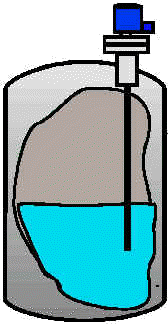The theory of operation for an RF Admittance level Sensor or transmitter is similar to that of Capacitance transmitters, but with two important circuit additions.
The oscillator buffer and chopper drive circuits permit separate measurement of resistance and capacitance.
Since the resistance and capacitance of any coating are of equal magnitude (by physical laws), the error generated by a coating can be measured and subtracted from the total output.
The result is an accurate measurement regardless of the amount of coating on the probe.
RF Admittance Level Sensor Theory

Advantages
RF Admittance is next generation capacitance as such it is by far the most versatile technology for continuous level measurement. It can handle a wide range of process conditions anywhere from cryogenics to approximately 850 o C and from vacuum to 10,000 psi pressure.
Aside from the electronic circuit technology, sensing element design is very important to handle these process conditions. There are no moving parts to wear, plug, or jam. As with capacitance systems there is only a single tank penetration, usually at the top of the tank, above the actual process level.
Disadvantages
RF admittance is intrusive. Insulating granular measurements require special considerations, such as the moisture range and location of the sensing element to minimize errors caused by probe movement.
Practical Notes
Admittance technology and nucleonic measurement provide the only practical methods for level measurement in coating applications. For insulating materials with changing dielectric constants, the measurement can only be made reliably if the material being measured is homogeneous.
A reference sensor is added to monitor the dielectric constant and then compensate the calibration based on this information. Smart RF transmitters are available providing superior levels of stability and accuracy as well as remote communication. Knowledge of the approximate electrical character of the process material is key to optimum system selection and performance.